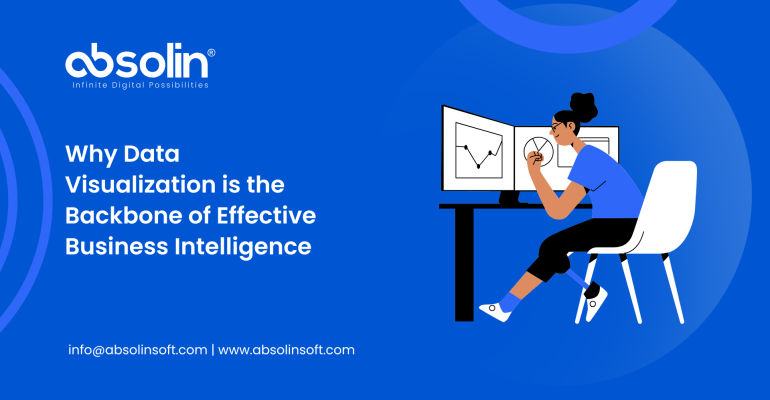Why Data Visualization is the Backbone of Effective Business Intelligence
In today’s fast-paced business landscape, data is being generated at an unprecedented rate. However, raw data, no matter how extensive, holds little value unless it can be effectively interpreted and transformed into actionable insights. This is where data visualization plays a crucial role in Business Intelligence (BI). It serves as the bridge between complex data sets and decision-makers, enabling them to comprehend trends, detect patterns, and drive strategic decisions with confidence.
The Role of Data Visualization in Business Intelligence
Business Intelligence encompasses a variety of processes, including data collection, analysis, and reporting. However, the effectiveness of BI solutions largely depends on how well the insights are communicated. Data visualization transforms raw numbers into interactive dashboards, charts, and graphs that provide instant clarity. Here’s why it is indispensable:
1. Simplifies Complex Data
Businesses deal with massive volumes of structured and unstructured data from various sources—CRM systems, financial reports, sales databases, social media, and more. Manually analyzing spreadsheets or text-based reports can be overwhelming. Data visualization simplifies complex datasets into visual representations like heatmaps, bar charts, and trend lines, making them easier to understand.
2. Enhances Decision-Making
Data-driven decision-making is at the core of business intelligence. Executives and managers often need to make quick decisions, and time-consuming data analysis can slow down operations. With visualized data, decision-makers can immediately spot patterns, trends, and outliers, enabling them to act swiftly and strategically.
For example, a sales manager reviewing a dashboard showcasing regional sales performance can quickly identify underperforming areas and allocate resources accordingly.
3. Identifies Trends and Patterns
One of the biggest advantages of visual analytics is its ability to uncover hidden patterns that might be missed in traditional reporting. Line graphs and time-series analysis help businesses track performance over months and years, enabling them to make proactive adjustments.
For instance, an e-commerce company analyzing website traffic data might notice that sales peak during specific hours or seasons. This insight allows them to optimize marketing campaigns and inventory accordingly.
4. Facilitates Real-Time Monitoring
In industries where real-time data tracking is crucial—such as finance, logistics, and healthcare—interactive dashboards enable businesses to monitor key metrics in real-time. This immediate access to data helps organizations react to market changes, system failures, or operational inefficiencies instantly.
For example, a logistics company can use a real-time supply chain dashboard to track shipments, identify delays, and take corrective actions before disruptions escalate.
5. Improves Collaboration Across Departments
Different teams within an organization often work with different datasets. Data visualization tools help unify data from multiple departments into a single, interactive dashboard, ensuring everyone has access to the same insights.
For example, a BI-powered dashboard for an FMCG company might combine marketing analytics, sales performance, and supply chain logistics, allowing cross-functional teams to work cohesively toward business objectives.
6. Reduces Cognitive Load and Saves Time
Numbers and spreadsheets require effort to interpret, whereas a well-designed chart can communicate the same information in seconds. This reduction in cognitive load allows employees to focus on strategy rather than spending hours deciphering data.
Imagine a financial analyst needing to compare quarterly profits. Instead of scanning rows of figures, a simple profit trend chart provides instant clarity.
7. Increases Data Accessibility for Non-Technical Users
Not everyone in an organization has a background in data science. Data visualization tools democratize data, making insights accessible to executives, managers, and frontline employees without requiring technical expertise.
For example, a heatmap showing customer engagement on a website allows a marketing team to refine its strategy without diving into complex analytics reports.
The Power of Interactive Dashboards
Traditional static reports are no longer sufficient for modern businesses. Interactive dashboards take data visualization a step further by allowing users to drill down into specific metrics, filter data dynamically, and generate custom reports on demand.
Popular BI tools like Power BI, Tableau, and Google Data Studio enable businesses to create custom dashboards tailored to their needs. These dashboards consolidate data from multiple sources, offering a 360-degree view of business performance.
Real-World Applications of Data Visualization in BI
- Retail: Stores use sales heatmaps to track customer behavior and optimize product placements.
- Healthcare: Hospitals utilize real-time patient monitoring dashboards to improve care quality.
- Finance: Investment firms analyze stock market trends through visual analytics.
- Manufacturing: Companies track production efficiency using real-time operational dashboards.
- Marketing: Digital marketing teams analyze campaign performance with interactive analytics.
Conclusion
Data visualization is not just a tool—it is the backbone of effective Business Intelligence. Without clear and actionable data representation, businesses risk misinterpreting critical insights, leading to poor decisions and missed opportunities. In an era where data is king, leveraging powerful visualization techniques ensures that organizations can stay competitive, agile, and data-driven. By integrating intelligent dashboards and real-time visual analytics, companies can unlock the full potential of their data, driving efficiency, innovation, and business success.






